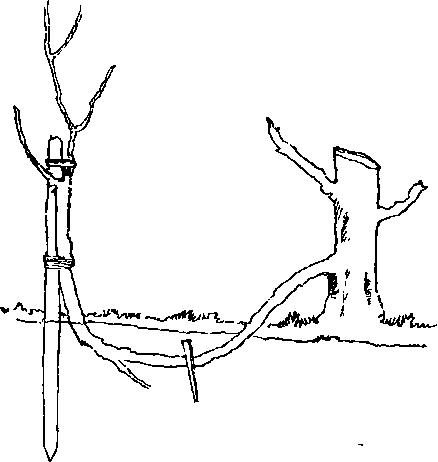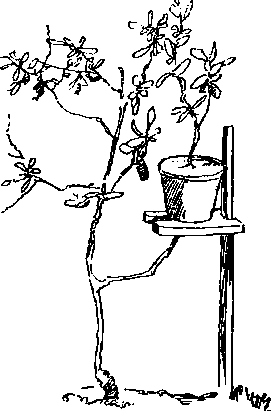Layering
Description
This section is from the book "Trees And Tree-Planting", by James S. Brisbin. Also available from Amazon: Trees and Tree Planting.
Layering
The method of layering has been obtained by observation of nature's growth, and has been established upon the fact of reproduction by the emission of roots from branches inserted in earth, under the same law which governs the growth of cuttings; though in layering, as in cuttings, the sap, which is the principle of growth in both, is not entirely restricted or cut off in its flow, but allowed a passage and continued supply till the production of roots, by the fact of its being necessarily kept in connection with its parent stem. The seasonable flow of sap which is drawn up by the roots of trees for the nourishment and growth of their stems and branches diffuses itself throughout, when, having performed its offices, it returns through the inner bark and deposits a thin layer of sap-wood or alburnum: so it may be conceived that the branches and roots are composed alike of this substance.
In layering, a branch may be chosen at a convenient height from, the ground, and, if not of such convenience, bent till brought in contact with the ground, as shown below, where it is to be inserted, or covered over with earth, and kept in position by means of a forked peg. Previous to insertion or covering over of the bent branch or layer an incision is commonly made in the lower side, generally of half the depth of the branch, and a slit run in the direction of the extremity of the limb of about the same length as the incision is in depth, or of such length as to allow of the easy upward turning of the layer, which is then to be doubly pinioned by an additional peg, driven so as to keep the limb in an upright position, to which it is to be lashed by means of bark bands, or other convenient material, so as to prevent its being disturbed by wind or other cause. When the growth of the limb or branch which it is intended to layer is not within easy bending distance of the ground, recourse is had to a contrivance which conveys the soil to the requisite height, so as conveniently to insert the branch at a particular point, and it grows naturally. For this purpose most generally an earthenware pot or wooden box is used, which is so made as to allow of a division of about two inches to the extent of half its breadth or diameter, and to its full height, for the easy insertion of the branch to its centre. On the branch being thus inserted, and the division closed by a piece of lath sufficiently wide to cover the opening or slit at the bottom and side, the pot is filled with earth, and so allowed to remain till the roots have formed upon the layer. It is, however, necessary that the outside of the pot or box be protected from the drying influence of the sun and wind, as too sudden or excessive evaporation necessitates frequent watering and, consequently, extra labor. The most fitting season for layering deciduous trees is in the spring when the leaves have just put forth, so as to take full advantage of the entire season's growth, for the perfecting of the roots previous to separating the branch from the parent stock in the following fall. The operation, however, should not be delayed longer than midsummer, unless it be intended that the layer should have the second season for perfecting its root, which is sometimes necessary in the case of some evergreens and deciduous trees tardy in emitting roots.


Continue to:
- prev: Cuttings
- Table of Contents
- next: Budding
